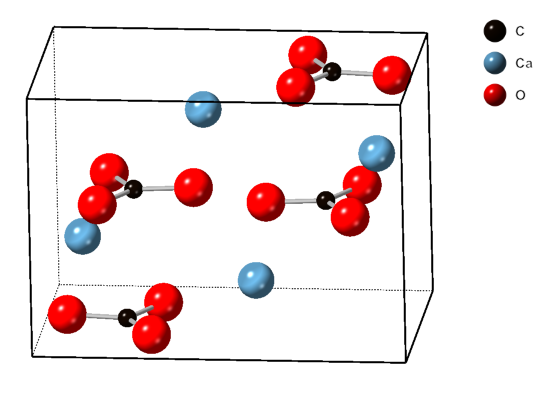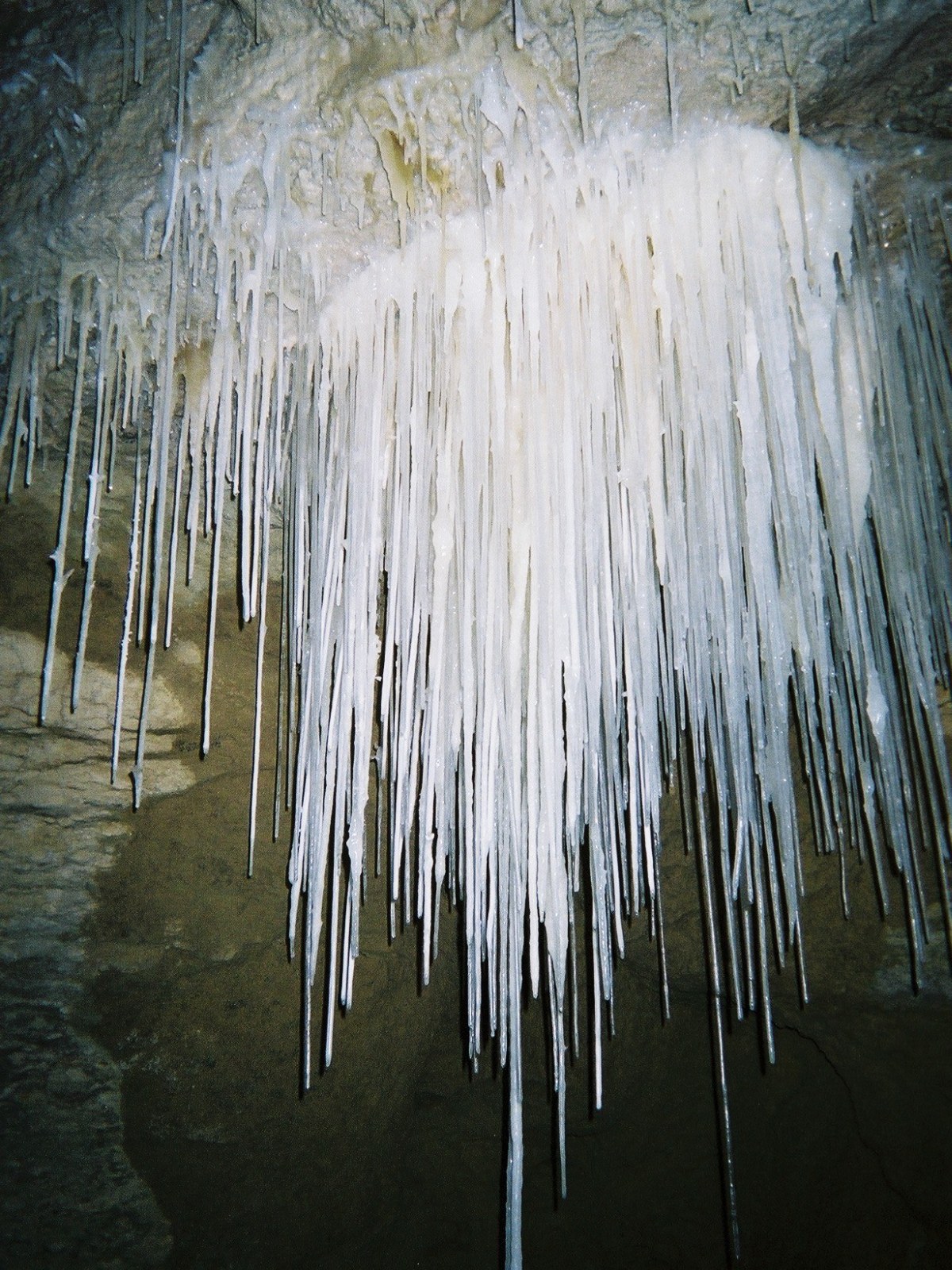|
Cave Popcorn
Cave popcorn, or coralloids, are small nodes of calcite, aragonite, or gypsum that form on surfaces in caves, especially limestone caves. They are a common type of speleothem. Appearance The individual nodules of cave popcorn range in size from 5 to 20 mm and may be decorated by other speleothems, especially aragonite needles or frostwork. The nodules tend to grow in clusters on bedrock or the sides of other speleothems. These clusters may terminate suddenly in either an upward or downward direction, forming a stratographic layer. When they terminate in a downward direction, they may appear as flat-bottomed formations known as trays. Individual nodes of popcorn can assume a variety of shapes from round to flattened ear-like or button-like shapes. The color of cave popcorn is usually white, but various other colors are possible depending on the composition. Formation Cave popcorn can form by precipitation. Water seeping through limestone walls or splashing onto them leaves ... [...More Info...] [...Related Items...] OR: [Wikipedia] [Google] [Baidu] |
Calcite
Calcite is a Carbonate minerals, carbonate mineral and the most stable Polymorphism (materials science), polymorph of calcium carbonate (CaCO3). It is a very common mineral, particularly as a component of limestone. Calcite defines hardness 3 on the Mohs scale of mineral hardness, based on Scratch hardness, scratch hardness comparison. Large calcite crystals are used in optical equipment, and limestone composed mostly of calcite has numerous uses. Other polymorphs of calcium carbonate are the minerals aragonite and vaterite. Aragonite will change to calcite over timescales of days or less at temperatures exceeding 300 °C, and vaterite is even less stable. Etymology Calcite is derived from the German , a term from the 19th century that came from the Latin word for Lime (material), lime, (genitive ) with the suffix ''-ite'' used to name minerals. It is thus a Doublet (linguistics), doublet of the word ''wikt:chalk, chalk''. When applied by archaeology, archaeologists and ... [...More Info...] [...Related Items...] OR: [Wikipedia] [Google] [Baidu] |
Aragonite
Aragonite is a carbonate mineral and one of the three most common naturally occurring crystal forms of calcium carbonate (), the others being calcite and vaterite. It is formed by biological and physical processes, including precipitation from marine and freshwater environments. The crystal lattice of aragonite differs from that of calcite, resulting in a different crystal shape, an orthorhombic crystal system with acicular crystal. Repeated twinning results in pseudo-hexagonal forms. Aragonite may be columnar or fibrous, occasionally in branching helictitic forms called ''flos-ferri'' ("flowers of iron") from their association with the ores at the Carinthian iron mines. Occurrence The type location for aragonite is Molina de Aragón in the Province of Guadalajara in Castilla-La Mancha, Spain, for which it was named in 1797. Aragonite is found in this locality as cyclic twins inside gypsum and marls of the Keuper facies of the Triassic. This type of aragoni ... [...More Info...] [...Related Items...] OR: [Wikipedia] [Google] [Baidu] |
Gypsum
Gypsum is a soft sulfate mineral composed of calcium sulfate Hydrate, dihydrate, with the chemical formula . It is widely mined and is used as a fertilizer and as the main constituent in many forms of plaster, drywall and blackboard or sidewalk chalk. Gypsum also Crystallization, crystallizes as translucent crystals of selenite (mineral), selenite. It forms as an evaporite mineral and as a Mineral hydration, hydration product of anhydrite. The Mohs scale of mineral hardness defines gypsum as hardness value 2 based on Scratch hardness, scratch hardness comparison. Fine-grained white or lightly tinted forms of gypsum known as alabaster have been used for sculpture by many cultures including Ancient Egypt, Mesopotamia, Ancient Rome, the Byzantine Empire, and the Nottingham alabasters of Medieval England. Etymology and history The word ''wikt:gypsum, gypsum'' is derived from the Greek language, Greek word (), "plaster". Because the quarry, quarries of the Montmartre district of P ... [...More Info...] [...Related Items...] OR: [Wikipedia] [Google] [Baidu] |
Cave
Caves or caverns are natural voids under the Earth's Planetary surface, surface. Caves often form by the weathering of rock and often extend deep underground. Exogene caves are smaller openings that extend a relatively short distance underground (such as rock shelters). Caves which extend further underground than the opening is wide are called endogene caves. Speleology is the science of exploration and study of all aspects of caves and the cave environment. Visiting or exploring caves for recreation may be called Caving, ''caving'', ''potholing'', or ''spelunking''. Formation types The formation and development of caves is known as ''speleogenesis''; it can occur over the course of millions of years. Caves can range widely in size, and are formed by various geological processes. These may involve a combination of chemical processes, erosion by water, tectonic forces, microorganisms, pressure, and atmospheric influences. Isotopic dating techniques can be applied to cave sedime ... [...More Info...] [...Related Items...] OR: [Wikipedia] [Google] [Baidu] |
Limestone
Limestone is a type of carbonate rock, carbonate sedimentary rock which is the main source of the material Lime (material), lime. It is composed mostly of the minerals calcite and aragonite, which are different Polymorphism (materials science), crystal forms of calcium carbonate . Limestone forms when these minerals Precipitation (chemistry), precipitate out of water containing dissolved calcium. This can take place through both biological and nonbiological processes, though biological processes, such as the accumulation of corals and shells in the sea, have likely been more important for the last 540 million years. Limestone often contains fossils which provide scientists with information on ancient environments and on the evolution of life. About 20% to 25% of sedimentary rock is carbonate rock, and most of this is limestone. The remaining carbonate rock is mostly Dolomite (rock), dolomite, a closely related rock, which contains a high percentage of the mineral Dolomite (mine ... [...More Info...] [...Related Items...] OR: [Wikipedia] [Google] [Baidu] |
Speleothem
A speleothem (; ) is a geological formation made by mineral deposits that accumulate over time in natural caves. Speleothems most commonly form in calcareous caves due to carbonate dissolution reactions. They can take a variety of forms, depending on their depositional history and environment. Their chemical composition, gradual growth, and preservation in caves make them useful paleoclimatic proxies. Chemical and physical characteristics More than 300 variations of cave mineral deposits have been identified. The vast majority of speleothems are calcareous, composed of calcium carbonate (CaCO3) minerals (calcite or aragonite). Less commonly, speleothems are made of calcium sulfate ( gypsum or mirabilite) or opal. Speleothems of pure calcium carbonate or calcium sulfate are translucent and colorless. The presence of iron oxide or copper provides a reddish brown color. The presence of manganese oxide can create darker colors such as black or dark brown. Speleothems can also b ... [...More Info...] [...Related Items...] OR: [Wikipedia] [Google] [Baidu] |
Frostwork
In geology, frostwork is a type of speleothem with acicular ("needle-like") growths almost always composed of aragonite (a polymorph of calcite) or calcite replaced aragonite.Hill, C. and Forti, P. (1997), ''Cave Minerals of the World'', National Speleological Society, 2nd Edition. It is a variety of anthodite. Frostwork can also be made of opal or gypsum. In some caves frostwork may grow on top of cave popcorn or boxwork. Formation The origin of frostwork is somewhat controversial. Formation of cave frostwork has been attributed to moist, circulating air which, containing dissolved calcium carbonate, drifted against rock surfaces and coated them with the delicate crystals. Frostwork has also been attributed to water seepage from cave passageways in which there are relatively high evaporation rates. Occurrence Notable frostwork deposits are found in a number of caves in the Black Hills region of South Dakota, US, most notable in Wind Cave National Park and Jewel Cave Na ... [...More Info...] [...Related Items...] OR: [Wikipedia] [Google] [Baidu] |
Flowstone
Flowstones are sheetlike deposits of calcite or other carbonate minerals, formed where water flows down the walls or along the floors of a cave. They are typically found in "solution caves", in limestone, where they are the most common speleothem. However, they may form in any type of cave where water enters that has picked up dissolved minerals. Flowstones are formed via the degassing of vadose percolation waters. Flowstone may also form on manmade structures as a result of calcium hydroxide being leached from concrete, lime or mortar. These secondary deposits created outside the cave environment, which mimic the shapes and forms of speleothems, are classified as "calthemites" and are associated with concrete degradation.Smith, G.K., (2016). “Calcite Straw Stalactites Growing From Concrete Structures”, Cave and Karst Science, Vol.43, No.1, P.4-10, (April 2016), British Cave Research Association, ISSN 1356-191X. Formation Flowing films of water that move along floors or do ... [...More Info...] [...Related Items...] OR: [Wikipedia] [Google] [Baidu] |
Popcorn
Popcorn (also called popped corn, popcorns, or pop-corn) is a variety of corn kernel which expands and puffs up when heated. The term also refers to the snack food produced by the expansion. It is one of the oldest snacks, with evidence of popcorn dating back thousands of years in the Americas. It is commonly eaten salted, buttered, sweetened, or with artificial flavorings. A popcorn kernel's strong hull contains the seed's hard, starchy shell endosperm with 14–20% moisture, which turns to steam as the kernel is heated. Pressure from the steam continues to build until the hull ruptures, allowing the kernel to forcefully expand, to 20 to 50 times its original size, and then cool. Some strains of corn ( taxonomized as ''Zea mays'') are cultivated specifically as popping corns. The ''Zea mays'' variety ''everta'', a special kind of flint corn, is the most common of these. Popcorn is one of six major types of corn, which includes dent corn, flint corn, pod corn, flour c ... [...More Info...] [...Related Items...] OR: [Wikipedia] [Google] [Baidu] |
Calthemite
Calthemite is a secondary deposit, derived from concrete, Lime (material), lime, Mortar (masonry), mortar or other calcareous material outside the cave environment.Smith, G.K. (2016). "Calcite straw stalactites growing from concrete structures", Cave and Karst Science 43(1), 4–10. http://bcra.org.uk/pub/candks/index.html?j=127Smith, G K., (2015). "Calcite Straw Stalactites Growing From Concrete Structures". Proceedings of the 30th 'Australian Speleological Federation' conference, Exmouth, Western Australia, edited by Moulds, T. pp 93 -108 Calthemites grow on or under man-made structures and mimic the shapes and forms of cave speleothems, such as stalactites, stalagmites, flowstone etc.Hill, C A and Forti, P, (1997). Cave Minerals of the World, Second Edition. [Huntsville, Alabama: National Speleological Society Inc.] Calthemite is derived from the Latin ''calx'' (genitive ''calcis'') "lime" + Latin < Greek ''théma'', "deposit" meaning ‘something laid down’, (also Mediaev ... [...More Info...] [...Related Items...] OR: [Wikipedia] [Google] [Baidu] |
Soda Straw
A soda straw (or simply straw) is a speleothem in the form of a hollow mineral cylinder (geometry), cylindrical tube. They are also known as tubular stalactites. Soda straws grow in places where water leaches slowly through cracks in rock, such as on the roofs of caves. Soda straws in caves rarely grow more than a few millimetres per year and may average one tenth of a millimetre per year.Hill, C A, and Forti, P, (1997). "Speleothem Growth Rates", Cave Minerals of the World, (2nd edition). [Huntsville, Alabama: National Speleological Society Inc.] pp 285 - 287 A soda straw can turn into a stalactite if the hole at the bottom is blocked, or if the water begins flowing on the outside surface of the hollow tube. Soda straws can also form outside the cave environment on exposed concrete surfaces as a type of calthemite, growing significantly faster than those formed on rock. Formation These tubes form when calcium carbonate or calcium sulfate dissolved in the water comes out of ... [...More Info...] [...Related Items...] OR: [Wikipedia] [Google] [Baidu] |








